Characterization of Oscillatory Response of Light-Weight Wind Turbine Rotors under Controlled Gust Pulses
Abstract
1. Introduction
2. Materials and Methods: The CODEF Model and Its Aeroelastic Modules
2.1. The CODEF Multiphysics Model for Wind Turbine/Wind Farm Dynamics and Its Modules
- Dynamic Blade Structural Model:
- 2.
- Individual Turbine Flow Model:
- 3.
- Wind Farm Flow Model:
2.2. The DRD-BEM Model
3. Results: A Characterization of the Oscillatory Dynamics of the SNL-NRT Rotor
- Pulses created by the cyclical motion of the blades traversing through a variable flow field: These correspond to an analysis situation of Steady-In-The-Average (SITA) wind conditions, where the stimuli of the aerodynamic load fluctuations come from the cyclical motion of the blades traversing through a variable flow field caused by wind shear, tilt and yaw.In these SITA cases, the frequency of fluctuations is mostly dominated by the rotor’s turning speed, which is comparatively slow versus other stimuli. It could be hypothesized that differences in dynamic response between the baseline blade and its more flexible variations are likely to become more intense when rapid temporal fluctuations, based on anemometry data, are added to the input wind. This is due to the fact that the different natural frequencies on the aeroelastic response of blades of different flexibility will be activated by short-term pulses in the wind signal. This will also affect the vortex-shedding process of the blades, altering the wake patterns for each of the different flexible variations.
- Pulses in the time signals of wind speed registered in the anemometry data: These have been typified and classified, according to amplitude and duration, in the previous work by the authors presented in Jalal et al. [18]. Section 3.1 of the present study, which covers the dynamics of the SNL-NRT rotor and its flexible variations, adopts the same pulse classification.
- Pulses created by the wake of a turbine located upwind: These have also been studied as part of the main body of the current research project. Because of the extension of that research thrust, results for those types of pulses are presented and discussed in a separate paper by the authors, which covers the aeroelastic response and wake characteristics of the SNL-NRT rotor and its flexible variations, when operating in a twin-turbine tandem configuration following a physical layout similar to the one at the SNL-SWiFT facility.
- Pulses created by the rapid application of control actions, like variable-speed operation, pitching, yawing or the eventual operation of flow control devices such as flaps: For the set of tests planned for the present study, it was the first three categories of pulses that were of interest. Pulses related to control actions were not designed or tested for the NRT rotor. As an outlook for further work, appropriate control actions may be elucidated from the present study, which can then be tested to see how a control action pulse affects the flexible blades.
3.1. The Oscillatory Response of Flexible Variations on the SNL-NRT Rotor
- BsLn: Baseline blade case.
- 60%SpSh: 60% shell and spar cap material.
- 40%Sp–60%Sh: 40% spar cap and 60% shell material.
- 40%SpSh: 40% shell and spar cap material.
- 20%Sp–40%Sh: 20% spar cap and 40% shell material.
- 20%SpSh: 20% shell and spar cap material.
- Short Pulses: Pulses in the “Short” category are the ones related with the small-scale motions on the wind flow turbulence spectrum. These pulses are sufficiently short so that they end before the blade reaches it first peak of oscillation. During an occurrence of a short pulse, there is a short initial time where the blades start to move and accumulate energy via inertia. The energy of a short pulse is then accumulated in the blades as mechanical potential energy via elastic deformation. Instantaneous blade deflection is then the only variable needed to characterize the overall evolution of the vibrational energy contained in the rotor as an oscillatory system.
- Transitional Pulses: Transitional pulses occur for a long enough period of time that the turbine’s blades start to experience mechanical energy loss via aerodynamic damping before the pulse ends. This results in only some of the pulse’s energy being transferred into elastic energy in the blade. Blade deflection alone is no longer sufficient to characterize the pulse’s energy transfer into the oscillatory system of the blades.
- Long Pulses: Pulses in the category of “Long” can be defined as being long enough to cause variations in the kinetic energy content of the incident flow which are gradual in nature, giving the blades enough time to absorb the pulse’s energy. These pulses may cause small, sometimes negligible, oscillations in the rotor’s system.
3.2. Energy Transfer Characterization of Gust Pulses
- 025P005: Amp 0.25 m/s–Tsp 0.05 s.
- 01P005: Amp 0.1 m/s–Tsp 0.05 s.
- 025P01: Amp 0.25 m/s–Tsp 0.1 s.
- 01P01: Amp 0.1 m/s–Tsp 0.1 s.
3.3. Exponential Decay of Gust-Pulse-Induced Oscillations
4. Conclusions and Discussion
Author Contributions
Funding
Data Availability Statement
Conflicts of Interest
References
- Tabor, A. Testing on the Ground Before You Fly: Wind Tunnels at NASA Ames. 2020. Available online: https://www.nasa.gov/centers-and-facilities/ames/testing-on-the-ground-before-you-fly-wind-tunnels-at-nasa-ames/ (accessed on 20 January 2024).
- Jonkman, J.; Butterfield, S.; Musial, W.; Scott, G. Definition of A 5-MW Reference Wind Turbine for Offshore System Development; Technical Report NREL/TP-500-38060; National Renewable Energy Laboratory: Golden, CO, USA, 2009. [Google Scholar]
- Ekaterinaris, J.A. Numerical simulation of incompressible two-blade rotor flowfields. J. Propuls. Power 1998, 14, 367–374. [Google Scholar] [CrossRef]
- Duque, E.; Van Dam, C.; Hughes, S. Navier-Stokes simulations of the NREL combined experiment phase II rotor. In Proceedings of the 37th Aerospace Sciences Meeting and Exhibit, Reno, NV, USA, 11–14 January 1999; p. 37. [Google Scholar]
- Sorensen, N. Aerodynamic predictions for the unsteady aerodynamics experiment phase-II rotor at the National Renewable Energy Laboratory. In Proceedings of the 2000 ASME Wind Energy Symposium, Reno, NV, USA, 10–13 January 2000; p. 37. [Google Scholar]
- Hansen, M.; Sorensen, J.; Michelsen, J.; Sorensen, N.; Hansen, M.; Sorensen, J.; Michelsen, J.; Sorensen, N. A global Navier-Stokes rotor prediction model. In Proceedings of the 35th Aerospace Sciences Meeting and Exhibit, Reno, NV, USA, 6–10 January 1997; p. 970. [Google Scholar]
- Maronga, B.; Gryschka, M.; Heinze, R.; Hoffmann, F.; Kanani-Sühring, F.; Keck, M.; Ketelsen, K.; Letzel, M.O.; Sühring, M.; Raasch, S. The Parallelized Large-Eddy Simulation Model (PALM) version 4.0 for atmospheric and oceanic flows: Model formulation, recent developments, and future perspectives. Geosci. Model Dev. 2015, 8, 2515–2551. [Google Scholar] [CrossRef]
- Churchfield, M.; Lee, S.; Moriarty, P.; Martinez, L.; Leonardi, S.; Vijayakumar, G.; Brasseur, J. A large-eddy simulation of wind-plant aerodynamics. In Proceedings of the 50th AIAA Aerospace Sciences Meeting including the New Horizons Forum and Aerospace Exposition, Nashville, TN, USA, 9–12 January 2012; p. 537. [Google Scholar]
- Domino, S. Sierra Low Mach Module: Nalu Theory Manual 1.0. 2015. Available online: https://nalu.readthedocs.io/en/latest/source/theory/index.html (accessed on 20 January 2024).
- Sprague, M.A.; Ananthan, S.; Vijayakumar, G.; Robinson, M. ExaWind: A multifidelity modeling and simulation environment for wind energy. J. Phys. Conf. Ser. 2020, 1452, 012071. [Google Scholar] [CrossRef]
- Van Bussel, G.J. The Aerodynamics of Horizontal Axis Wind Turbine Rotors Explored with Asymptotic Expansion Methods. Ph.D. Thesis, Delft University of Technology, Delft, The Netherlands, 1995. [Google Scholar]
- Gebraad, P.M.; Teeuwisse, F.W.; Van Wingerden, J.; Fleming, P.A.; Ruben, S.D.; Marden, J.R.; Pao, L.Y. Wind plant power optimization through yaw control using a parametric model for wake effects—A CFD simulation study. Wind Energy 2016, 19, 95–114. [Google Scholar] [CrossRef]
- Doubrawa, P.; Quon, E.W.; Martinez-Tossas, L.A.; Shaler, K.; Debnath, M.; Hamilton, N.; Herges, T.G.; Maniaci, D.; Kelley, C.L.; Hsieh, A.S.; et al. Multimodel validation of single wakes in neutral and stratified atmospheric conditions. Wind Energy 2020, 23, 2027–2055. [Google Scholar] [CrossRef]
- Lignarolo, L.E.; Mehta, D.; Stevens, R.J.; Yilmaz, A.E.; van Kuik, G.; Andersen, S.J.; Meneveau, C.; Ferreira, C.J.; Ragni, D.; Meyers, J.; et al. Validation of four LES and a vortex model against stereo-PIV measurements in the near wake of an actuator disc and a wind turbine. Renew. Energy 2016, 94, 510–523. [Google Scholar] [CrossRef]
- Manwell, J.F.; McGowan, J.G.; Rogers, A.L. Wind Energy Explained: Theory, Design and Application; Wiley: Chichester, UK, 2009. [Google Scholar]
- Burton, T.; Sharpe, D.; Jenkins, N.; Bossanyi, E. Wind Energy Handbook; Wiley: Chichester, UK, 2001. [Google Scholar]
- Ponta, F.L.; Otero, A.D.; Lago, L.I.; Rajan, A. Effects of rotor deformation in wind-turbine performance: The Dynamic Rotor Deformation Blade Element Momentum model (DRD–BEM). Renew. Energy 2016, 92, 157–170. [Google Scholar] [CrossRef]
- Jalal, S.; Ponta, F.; Baruah, A.; Rajan, A. Dynamic Aeroelastic Response of Stall-Controlled Wind Turbine Rotors in Turbulent Wind Conditions. Appl. Sci. 2021, 11, 6886. [Google Scholar] [CrossRef]
- Jaimes, O.G. Design Concepts for Offshore Wind Turbines: A Technical and Economical Study on the Trade-off Between Stall and Pitch Controlled Systems. Ph.D. Thesis, Delft University of Technology, Delft, The Netherlands, 2010. [Google Scholar]
- Kelley, C.L.; Ennis, B.L. SWiFT Site Atmospheric Characterization; Technical Report SAND2016-0216; Sandia National Lab.: Albuquerque, NM, USA, 2016. [Google Scholar]
- Berg, J.; Bryant, J.; LeBlanc, B.; Maniaci, D.C.; Naughton, B.; Paquette, J.A.; Resor, B.R.; White, J.; Kroeker, D. Scaled wind farm technology facility overview. In Proceedings of the 32nd ASME Wind Energy Symposium, National Harbor, MD, USA, 13–17 January 2014; p. 1088. [Google Scholar]
- Barone, M.F.; White, J. DOE/SNL-TTU Scaled Wind Farm Technology Facility; Technical Report SAND2011-6522; Sandia National Lab.: Albuquerque, NM, USA, 2011. [Google Scholar]
- Ponta, F.L.; Jacovkis, P.M. A vortex model for Darrieus turbine using finite element techniques. Renew. Energy 2001, 24, 1–18. [Google Scholar] [CrossRef]
- Strickland, J.H.; Webster, B.T.; Nguyen, T. A Vortex Model of the Darrieus Turbine: An Analytical and Experimental Study. J. Fluids Eng. 1979, 101, 500–505. [Google Scholar] [CrossRef]
- Cottet, G.H.; Koumoutsakos, P.D. Vortex Methods: Theory and Practice; Cambridge University Press: London, UK, 2000. [Google Scholar]
- Karamcheti, K. Principles of Ideal-Fluid Aerodynamics; Wiley: New York, NY, USA, 1966. [Google Scholar]
- Ponta, F.L. Vortex decay in the Kármán eddy street. Phys. Fluids 2010, 22, 093601. [Google Scholar] [CrossRef]
- Lamb, H. Hydrodynamics, 6th ed.; Cambridge University Press: Cambridge, UK, 1932. [Google Scholar]
- Batchelor, G.K. An Introduction to Fluid Dynamics; Cambridge University Press: Cambridge, UK, 2000. [Google Scholar]
- Trieling, R.R.; van Wesenbeeck, J.M.A.; van Heijst, G.J.F. Dipolar vortices in a strain flow. Phys. Fluids 1998, 10, 144–159. [Google Scholar] [CrossRef]
- Flór, J.B.; van Heijst, G.J.F. An experimental study of dipolar structures in a stratified fluid. J. Fluid Mech. 1994, 279, 101–133. [Google Scholar] [CrossRef]
- Hooker, S.G. On the action of viscosity in increasing the spacing ration of a vortex street. Proc. Roy. Soc. 1936, A154, 67–89. [Google Scholar]
- Kelley, C.L. Aerodynamic Design of the National Rotor Testbed; Technical Report SAND2015-8989; Sandia National Lab.: Albuquerque, NM, USA, 2015. [Google Scholar]
- Menon, M.; Ponta, F. Aeroelastic Response of Wind Turbine Rotors under Rapid Actuation of Flap-Based Flow Control Devices. Fluids 2022, 7, 129. [Google Scholar] [CrossRef]


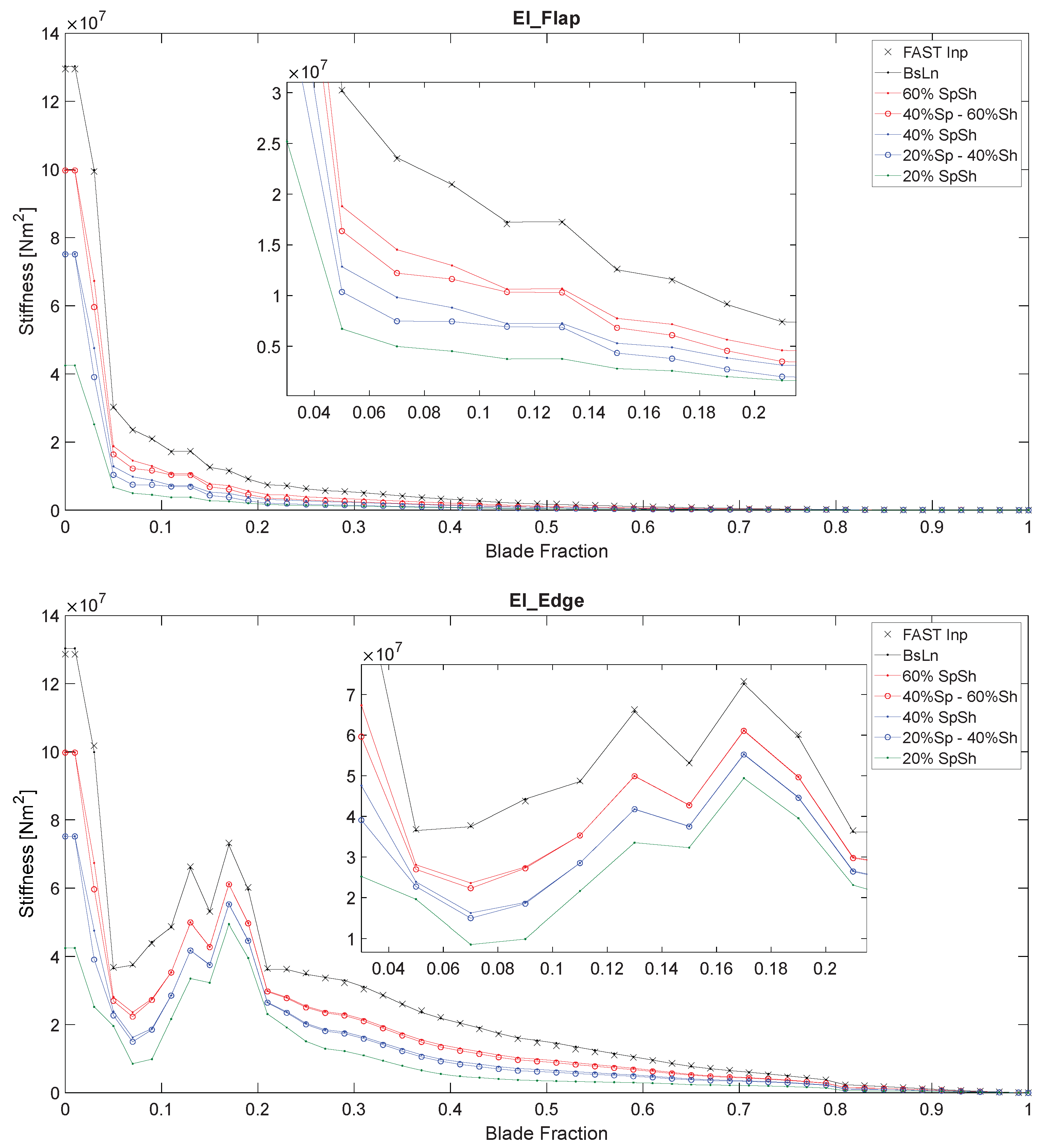
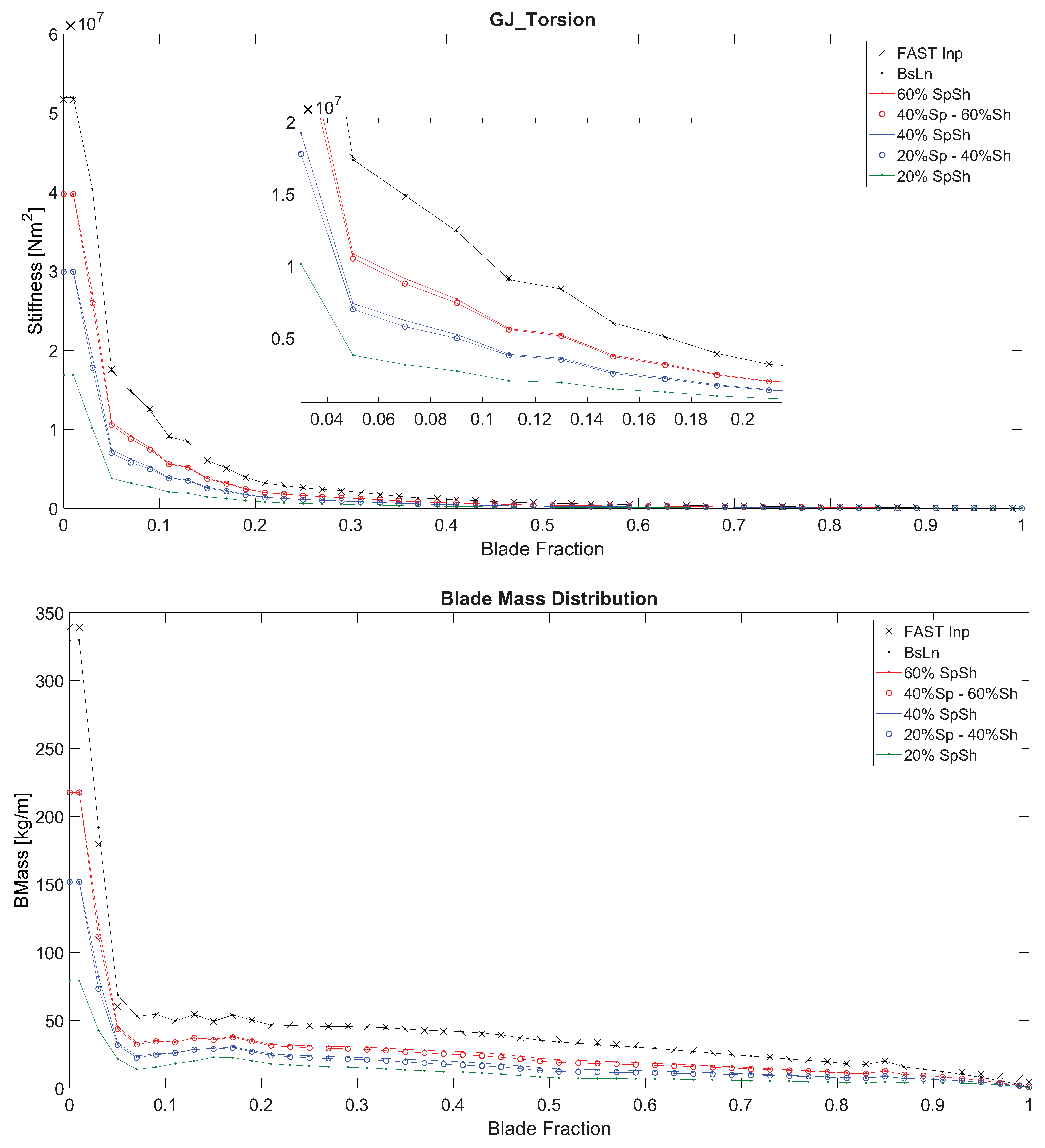
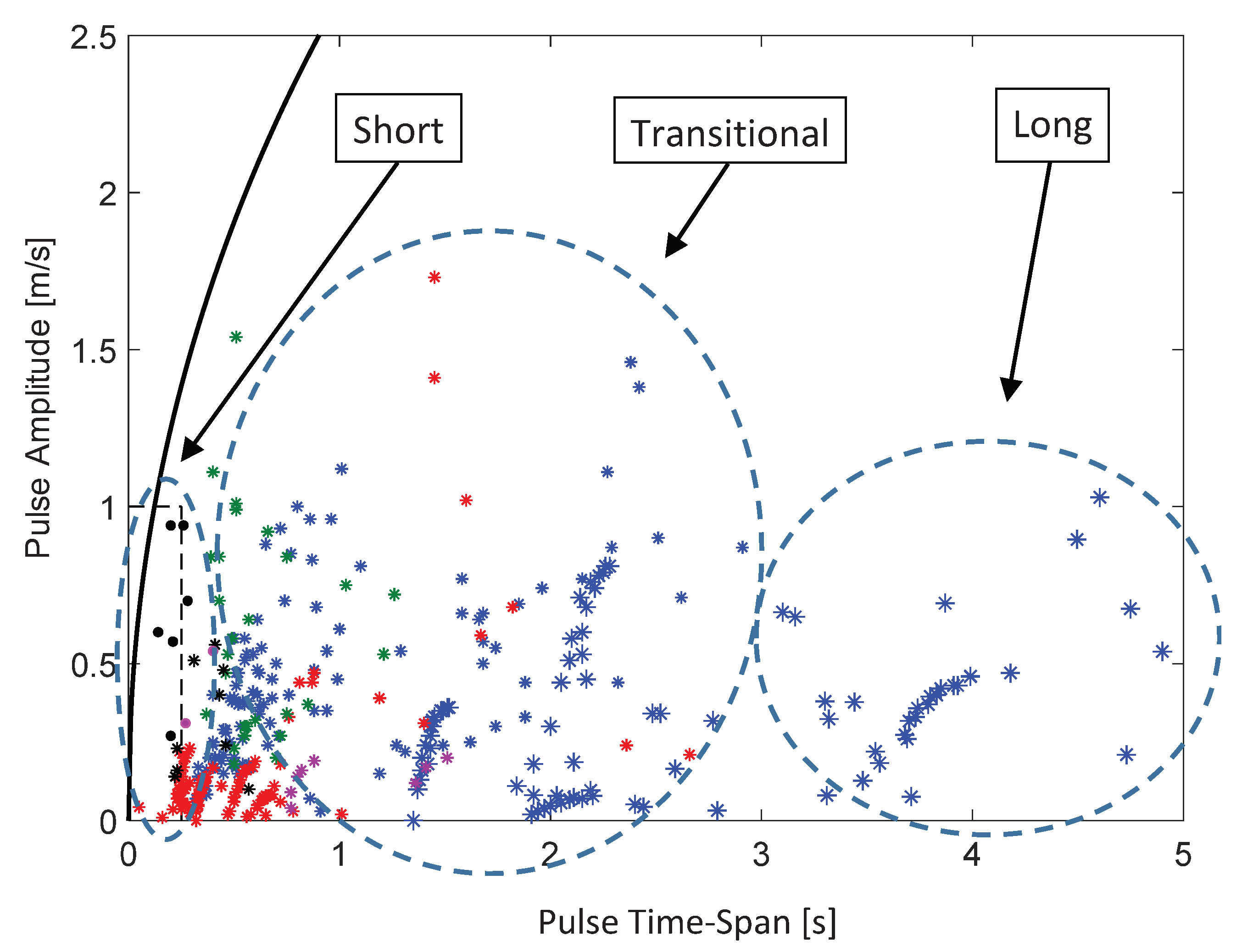


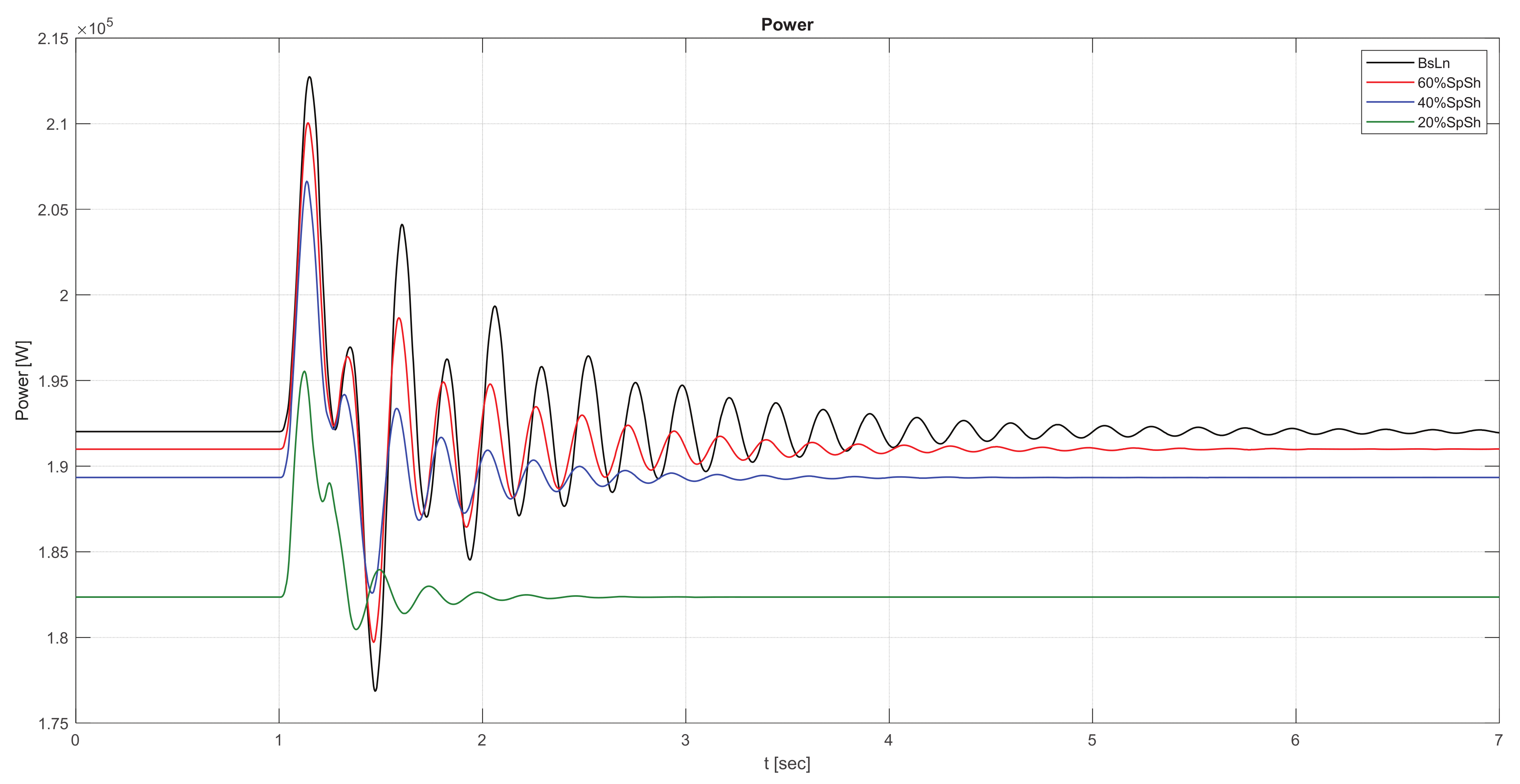
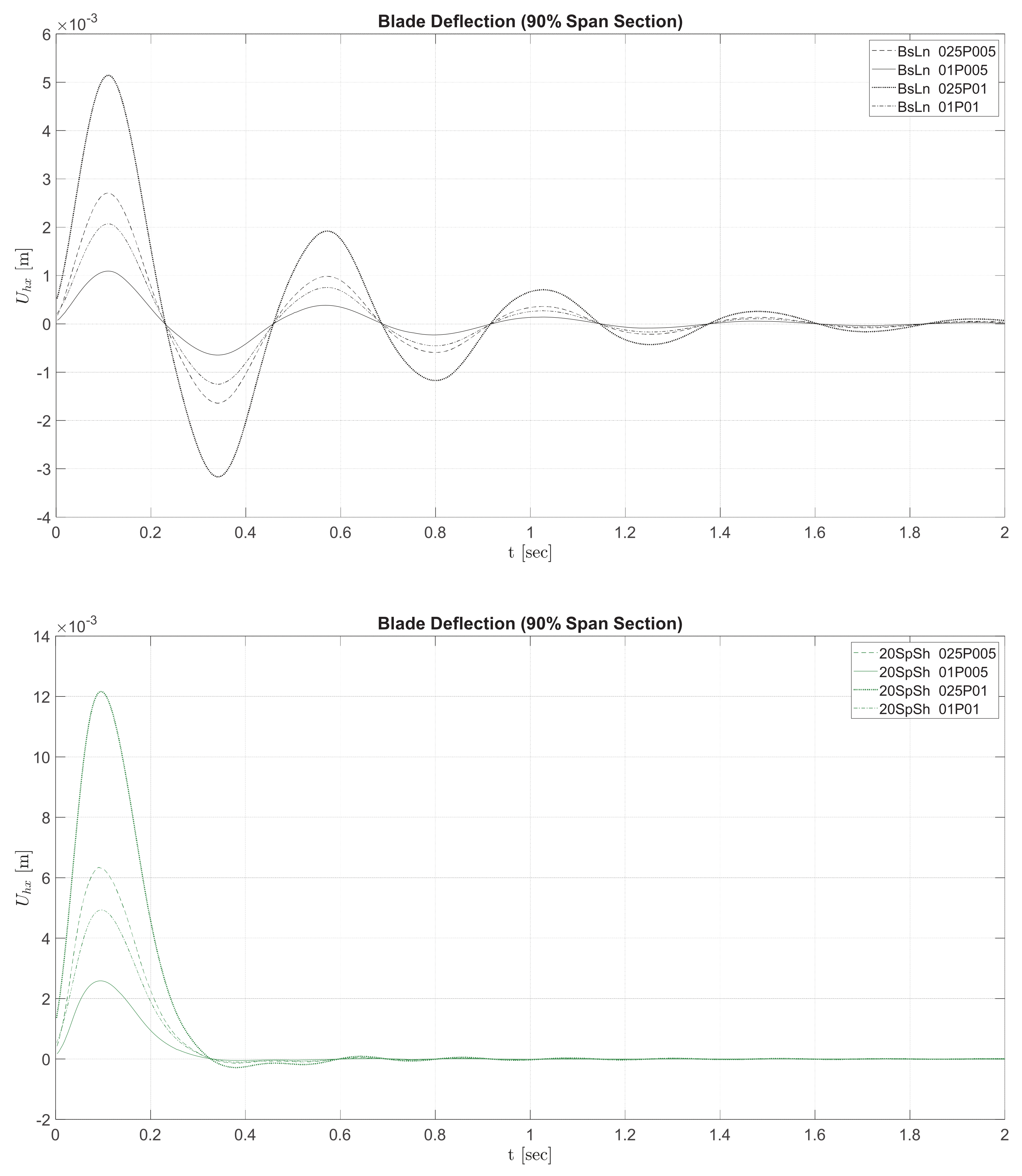
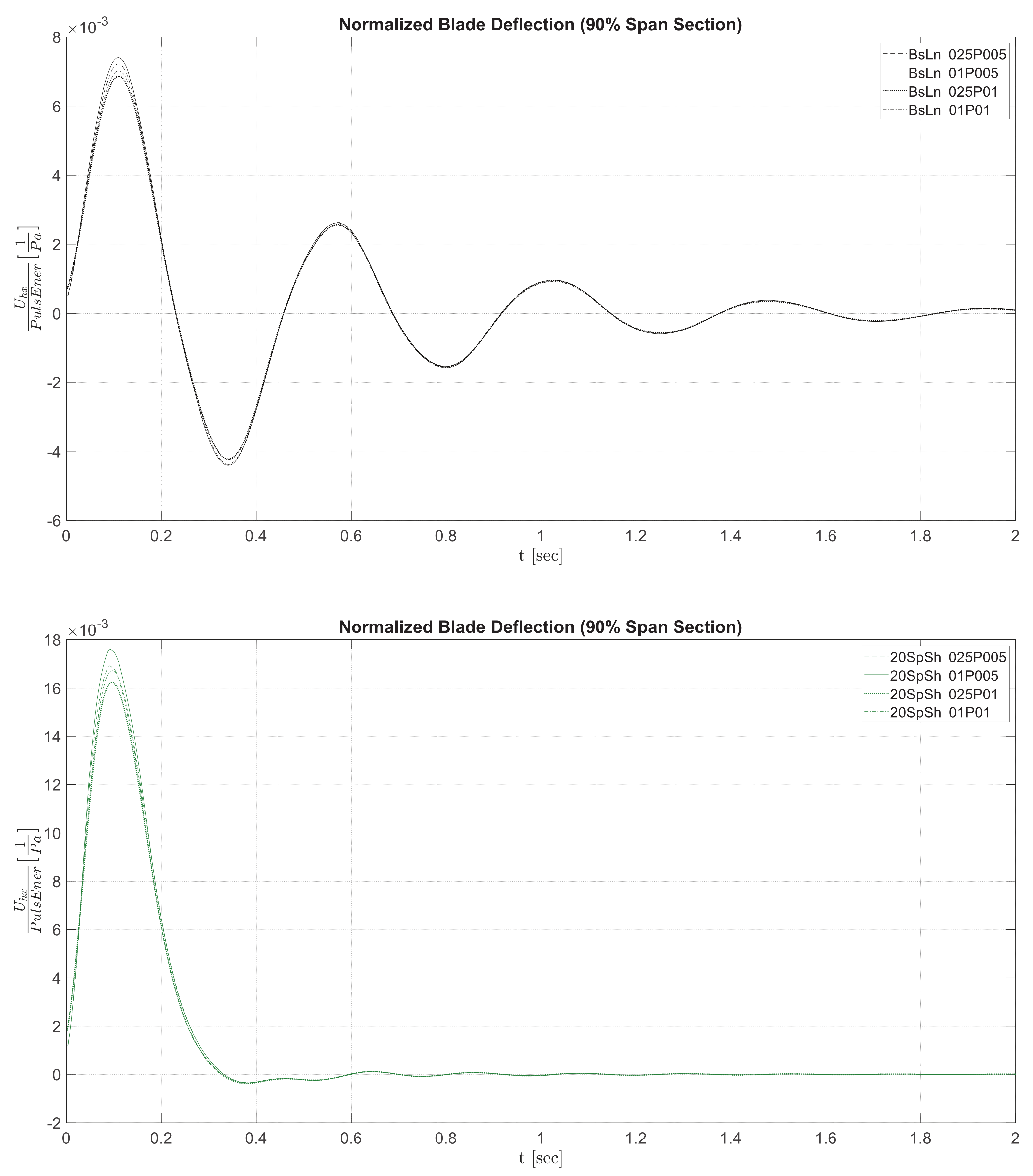

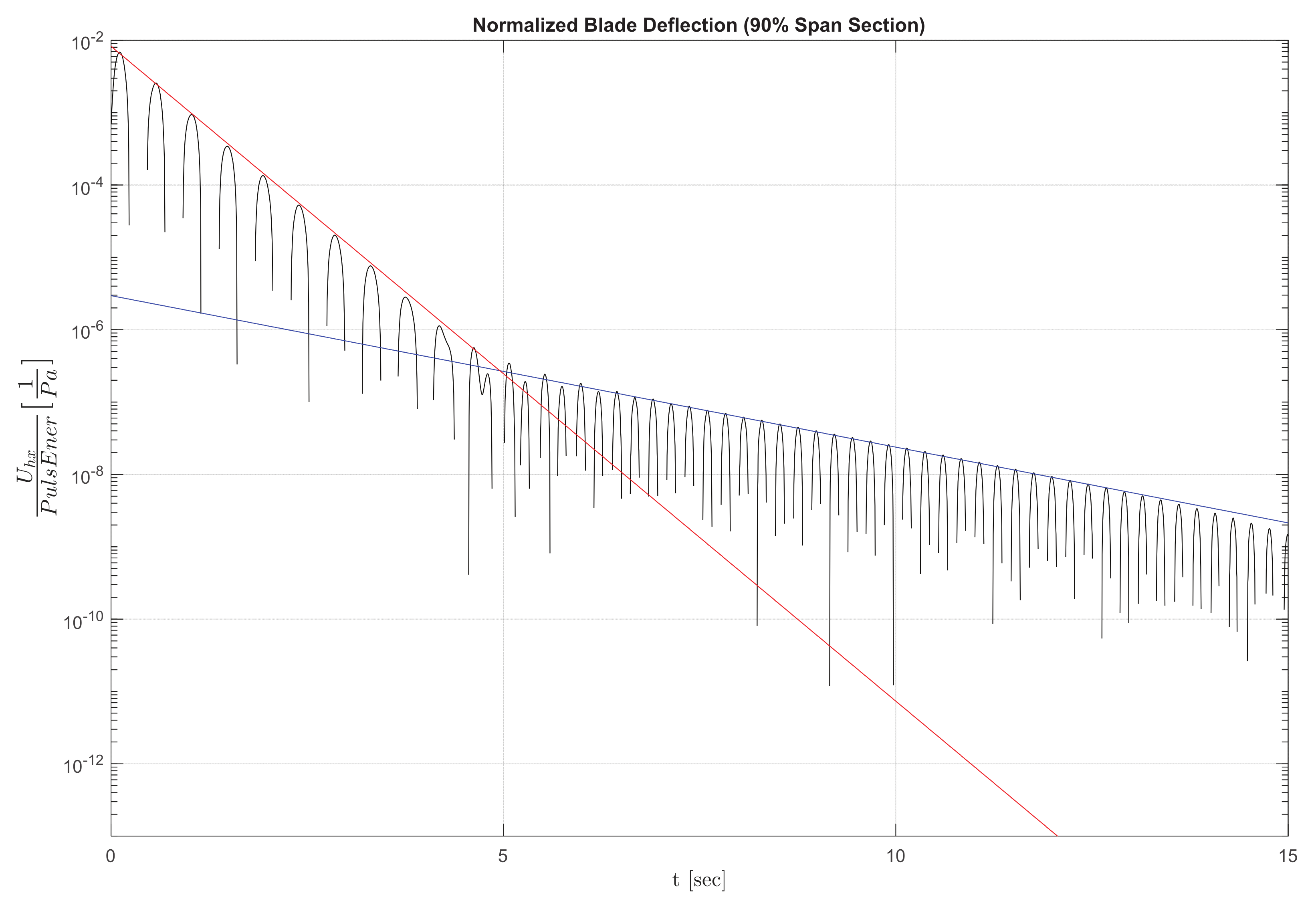


| Blade Variant | Mass (Kg) | % BsLn Mass |
|---|---|---|
| BsLn | 551.157 | 100.000 |
| 60%SpSh | 360.594 | 65.425 |
| 40%Sp–60%Sh | 344.863 | 62.571 |
| 40%SpSh | 260.445 | 47.254 |
| 20%Sp–40%Sh | 244.601 | 44.380 |
| 20%SpSh | 156.286 | 28.356 |
Disclaimer/Publisher’s Note: The statements, opinions and data contained in all publications are solely those of the individual author(s) and contributor(s) and not of MDPI and/or the editor(s). MDPI and/or the editor(s) disclaim responsibility for any injury to people or property resulting from any ideas, methods, instructions or products referred to in the content. |
© 2024 by the authors. Licensee MDPI, Basel, Switzerland. This article is an open access article distributed under the terms and conditions of the Creative Commons Attribution (CC BY) license (https://creativecommons.org/licenses/by/4.0/).
Share and Cite
Ponta, F.; Farrell, A.; Baruah, A.; Yates, N. Characterization of Oscillatory Response of Light-Weight Wind Turbine Rotors under Controlled Gust Pulses. Fluids 2024, 9, 83. https://doi.org/10.3390/fluids9040083
Ponta F, Farrell A, Baruah A, Yates N. Characterization of Oscillatory Response of Light-Weight Wind Turbine Rotors under Controlled Gust Pulses. Fluids. 2024; 9(4):83. https://doi.org/10.3390/fluids9040083
Chicago/Turabian StylePonta, Fernando, Alayna Farrell, Apurva Baruah, and North Yates. 2024. "Characterization of Oscillatory Response of Light-Weight Wind Turbine Rotors under Controlled Gust Pulses" Fluids 9, no. 4: 83. https://doi.org/10.3390/fluids9040083
APA StylePonta, F., Farrell, A., Baruah, A., & Yates, N. (2024). Characterization of Oscillatory Response of Light-Weight Wind Turbine Rotors under Controlled Gust Pulses. Fluids, 9(4), 83. https://doi.org/10.3390/fluids9040083







